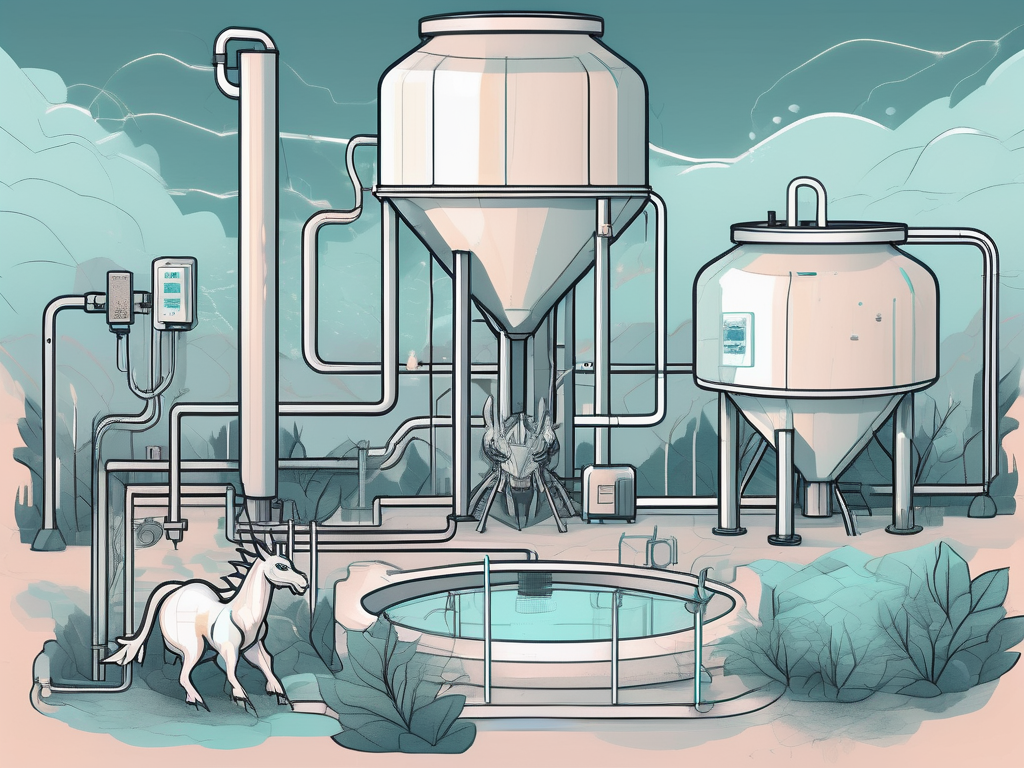
Separating Fact from Fiction: Understanding Remote Monitoring in Wastewater Management
In the realm of wastewater management, remote monitoring has become an increasingly important tool. However, there are still many misconceptions surrounding this technology. In this article, we will explore the role and importance of remote monitoring in wastewater management, debunk common myths associated with it, and discuss the future of this innovative solution.
Understanding Remote Monitoring in Wastewater Management
The Role and Importance of Remote Monitoring
Remote monitoring plays a vital role in modern wastewater management systems. It allows operators to continuously monitor various parameters, such as water quality, flow rates, and equipment performance, without the need for constant on-site presence.
Traditionally, wastewater management involved manual data collection, which was time-consuming and often prone to human error. Remote monitoring systems have revolutionized this process by providing real-time data acquisition and analysis. This enables operators to detect issues more quickly, respond promptly, and optimize system performance.
Imagine a bustling wastewater treatment plant, where operators used to spend countless hours manually collecting data from different points in the system. They would have to physically go to each location, take measurements, and record the data. This process was not only labor-intensive but also left room for human error. With remote monitoring systems, operators can now sit in a control room and access all the necessary data with just a few clicks. This not only saves time and effort but also ensures accuracy and reliability in data collection.
Key Components of Remote Monitoring Systems
A remote monitoring system typically includes several key components:
- Sensors: These devices capture data about the wastewater, such as pH levels, turbidity, and temperature.
- Transmitters: Transmitters convert the sensor data into digital signals that can be transmitted wirelessly or via wired connections.
- Communication Network: This network facilitates the transfer of data from the sensors to a central server or control room.
- Data Storage and Analysis: The collected data is stored and analyzed to identify trends, anomalies, and potential issues.
- Alert System: If any parameters fall outside the specified range, an alert is triggered to notify operators.
Let's delve deeper into the communication network component of a remote monitoring system. This network acts as the backbone of the entire system, enabling seamless data transfer from the sensors to the control room. It can utilize various technologies, such as cellular networks, Wi-Fi, or even dedicated communication lines, depending on the specific requirements of the wastewater management facility. The choice of communication network is crucial as it determines the reliability, speed, and security of data transmission.
Once the data reaches the control room, it is stored and analyzed using advanced software tools. These tools allow operators to visualize the data in real-time, identify trends, and detect any anomalies that may indicate potential issues. By analyzing the data, operators can make informed decisions regarding system maintenance, optimization, and resource allocation. This data-driven approach not only improves the overall efficiency of wastewater management but also helps in meeting regulatory compliance requirements.
Common Misconceptions About Remote Monitoring
Remote monitoring has become an increasingly popular solution for wastewater systems, but there are still some common misconceptions that need to be addressed. In this article, we will debunk three of the most prevalent myths surrounding remote monitoring and shed light on the truth behind them.
Myth 1: Remote Monitoring is Too Expensive
One common myth surrounding remote monitoring is that it is overly expensive and not cost-effective for wastewater systems. While there is an initial investment required for implementing a remote monitoring system, the long-term benefits outweigh the costs.
Remote monitoring eliminates the need for manual data collection, which reduces labor costs. It also allows for predictive maintenance, preventing costly breakdowns and repairs. Moreover, the ability to optimize system performance based on real-time data can lead to significant energy savings.
Furthermore, remote monitoring systems are designed to be scalable, allowing for gradual implementation and expansion based on budgetary constraints. This means that even smaller wastewater systems can benefit from remote monitoring without breaking the bank.
Myth 2: The Technology is Unreliable
Another misconception is that remote monitoring technology is unreliable and prone to technical issues. However, advancements in technology have made remote monitoring systems highly reliable and robust.
Modern remote monitoring systems are designed to withstand harsh environmental conditions and are equipped with failsafe mechanisms. They are built to endure extreme temperatures, humidity, and even corrosive substances commonly found in wastewater systems. Additionally, regular maintenance and calibration ensure accurate and dependable data collection.
Moreover, remote monitoring systems are equipped with real-time alerts and notifications, allowing operators to quickly respond to any technical issues that may arise. This proactive approach minimizes downtime and ensures continuous monitoring and data collection.
Myth 3: It's Not Suitable for All Wastewater Systems
Some believe that remote monitoring is only suitable for large-scale wastewater systems and not applicable to smaller or decentralized systems. This is far from the truth.
Remote monitoring systems can be tailored to fit the specific needs and scale of any wastewater system. Whether it is a municipal wastewater treatment plant, an industrial facility, or a remote location with limited connectivity, remote monitoring can be customized to provide valuable insights and improve operations.
For smaller or decentralized systems, remote monitoring can be implemented using wireless communication technologies, such as cellular networks or satellite connections. These solutions ensure reliable data transmission and allow operators to monitor and control their systems from anywhere, regardless of the system's size or location.
As you can see, remote monitoring is a cost-effective, reliable, and scalable solution that can benefit wastewater systems of all sizes. By debunking these misconceptions, we hope to encourage more operators to explore the possibilities of remote monitoring and unlock the numerous advantages it offers.
The Truth About Remote Monitoring in Wastewater
The Cost-effectiveness of Remote Monitoring
Contrary to popular belief, remote monitoring systems are cost-effective in the long run. The initial investment pays off through labor savings, improved maintenance practices, and energy efficiency. With accurate data and proactive monitoring, operators can optimize chemical dosing, equipment usage, and overall system performance, resulting in substantial cost savings.
Furthermore, the cost-effectiveness of remote monitoring extends beyond financial savings. By reducing the need for manual inspections and on-site visits, remote monitoring also enhances safety by minimizing exposure to hazardous conditions for operators and technicians. This not only safeguards personnel but also reduces the risk of accidents and injuries in wastewater treatment facilities.
Reliability and Accuracy of Remote Monitoring Technology
As technology continues to advance, remote monitoring systems have become highly reliable and accurate. Sensors are calibrated regularly, and the data is cross-verified to ensure consistency and quality. By monitoring multiple parameters in real time, operators can identify potential issues and respond promptly, minimizing downtime and preventing environmental incidents.
Moreover, the reliability and accuracy of remote monitoring technology play a crucial role in regulatory compliance. With precise data collection and reporting capabilities, operators can demonstrate adherence to environmental regulations and standards, avoiding fines and penalties. This transparency and accountability also foster public trust and confidence in the wastewater treatment process.
Versatility and Adaptability of Remote Monitoring Systems
Remote monitoring systems are incredibly versatile and adaptable to various wastewater systems. Whether it is a small-scale treatment plant, sewer network, or stormwater management, remote monitoring can be tailored to the specific requirements. Additionally, remote monitoring facilitates remote access to data, enabling operators to make informed decisions and remotely troubleshoot issues.
Furthermore, the versatility of remote monitoring systems extends to scalability, allowing for seamless integration with existing infrastructure and future expansion. This scalability ensures that as wastewater treatment facilities grow or undergo modifications, the remote monitoring system can evolve in tandem, providing continuous support and optimization capabilities.
The Future of Remote Monitoring in Wastewater
Emerging Trends in Remote Monitoring
The future of remote monitoring in wastewater holds even more promise. Advanced technologies such as artificial intelligence (AI), machine learning, and Internet of Things (IoT) are being integrated into remote monitoring systems. These developments will enhance data analysis, predictive capabilities, and automation, further improving efficiency and reducing operational costs.
Potential Benefits and Opportunities
With the continued advancement of remote monitoring technology, there are numerous benefits and opportunities to explore. Real-time monitoring facilitates early detection of pollutant spikes, enabling prompt action to protect the environment and public health. It also provides valuable data for research and analysis, supporting evidence-based decision-making in wastewater management.
Preparing for the Future of Wastewater Management
As remote monitoring becomes more prevalent in wastewater management, it is essential for operators and stakeholders to stay informed and embrace these technological advancements. Training programs and knowledge sharing platforms can help bridge any knowledge gaps and ensure optimal utilization of remote monitoring systems for sustainable and efficient wastewater management.
In addition to the exciting advancements in remote monitoring technology, there are other emerging trends that will shape the future of wastewater management. One such trend is the integration of remote monitoring systems with smart sensors and actuators. These devices can automatically adjust valves, pumps, and other equipment based on real-time data, optimizing the performance of wastewater treatment plants and reducing energy consumption.
Furthermore, remote monitoring can also play a crucial role in asset management. By continuously monitoring the condition and performance of equipment, operators can identify maintenance needs and schedule repairs before major breakdowns occur. This proactive approach not only minimizes downtime but also extends the lifespan of expensive equipment, resulting in significant cost savings for wastewater treatment facilities.
Another area where remote monitoring holds great potential is in the detection and prevention of illegal dumping. By deploying remote monitoring systems in strategic locations, authorities can monitor wastewater discharge points and detect any unauthorized or harmful substances being released into the environment. This proactive surveillance can help deter illegal activities and protect the integrity of our water resources.
In conclusion, remote monitoring in wastewater management is a valuable tool that dispels common myths surrounding its effectiveness, cost, and reliability. The technology enables continuous monitoring, data-driven decision-making, and proactive maintenance, leading to improved system performance and cost savings. As we look to the future, remote monitoring will continue to evolve, offering even greater benefits and opportunities for efficient wastewater management.
